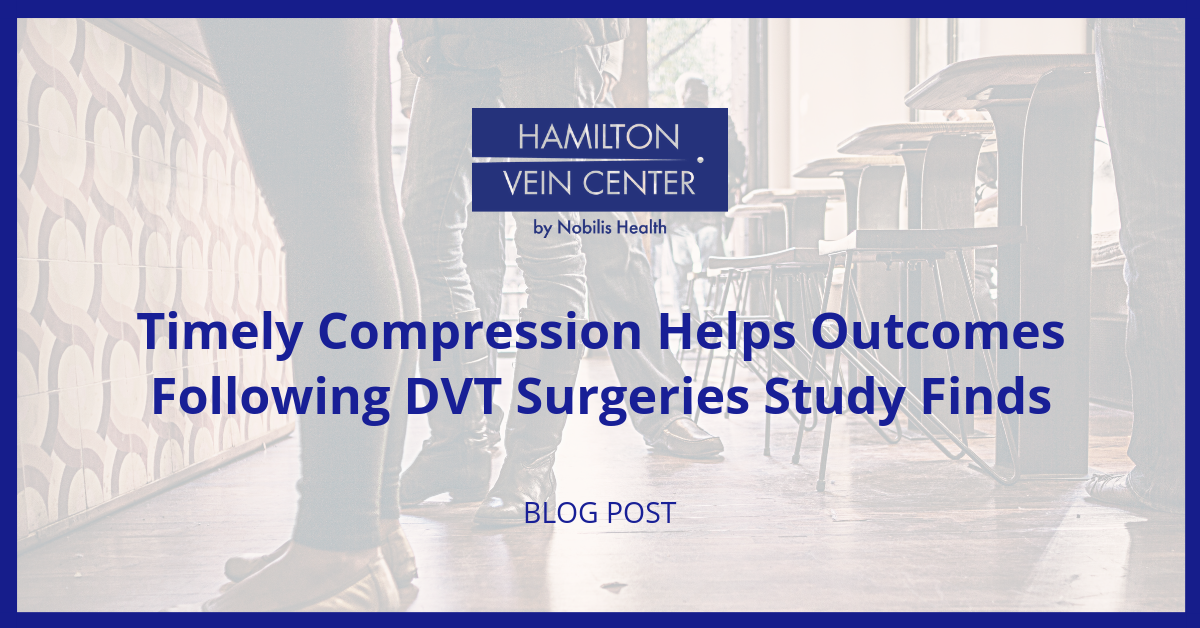Timely Compression Helps Outcomes Following DVT Surgeries Study Finds

DVT Therapy & Outcomes
Deep vein thrombosis (DVT), or clotting in veins deep inside the leg, is a dangerous condition the complications of which sometimes lead to serious problems and even death. Medical interventions such as the taking of prescribed blood thinners can help with this problem, but, in some cases, surgical approaches like venous thrombectomy may be called for. The latter are highly effective; however, as with any such surgery, there’s always a risk for complications.
Most often emphasis on the part of doctors has been on ensuring postoperative patients are taking medications. That said, a recent study published in the academic journal, Blood, notes that compression therapy, if started early on after diagnosis, can help reduce incidence of dangerous complications after surgery. [1] This has major implications for the treatment of DVT, so let’s take a closer look.
Preventing Postthrombotic Syndrome
Before learning more about the study, it’s important to get a sense of the complications that can arise following DVT treatment. The most common long-term problem—and the one focused on in this study—is postthrombotic syndrome, a chronic condition that occurs within one to two years of treatment. [1] It’s characterized by some of the same symptoms that lead people to getting treatment in the first place: pain, leg heaviness, skin discoloration, leg ulceration, and others.
The main task of health management post-surgery is ensuring that postthrombotic syndrome doesn’t arise, and the emphasis in treatment has been pharmacological. However, according to Dr. Elham E. Amin and a team of Holland-based researchers, compression therapy—especially within the first 24 hours of diagnosis of DVT—should be applied even before medical treatment of the condition. [1]
Breaking Down the Study
The main focus of the study was to see the effect of wearing compression stockings for extended periods of time on residual vein occlusion, a precursor to postthrombotic syndrome defined as when clots remain in veins following treatment. They assessed roughly 600 Dutch DVT patients, split up between those who underwent compression therapy within 24 hours of DVT diagnosis and those who did not. [1]
The measurements sought out by Dr. Amin and the team were the presence of residual vein occlusion and postthrombotic syndrome at five, six, and 24 months after surgery. A clear effect was seen: those who underwent this immediate compression therapy were 20 percent less likely to develop residual vein occlusions and had an eight percent lower rate of developing postthrombotic syndrome. [1] Since all of the research subjects were also taking anticoagulant, blood-thinning drugs, the efficacy and importance of this approach was underscored.
Stepping Forward Towards Better
The implications of this research are quite clear: compression therapy is essential not only after surgery for DVT—as it’s often indicated—but even at the moment of diagnosis. In fact, this is a more standard practice in Europe than in the USA. [2] Furthermore, the beauty of this approach is that “compression stockings are fairly easy to self-administer, relatively inexpensive, and minimally intrusive” according to Dr. Ten Cate-Hoek, one of the study’s senior researchers, who goes on to say, “compression therapy offers a clear benefit for all patients with DVT.” [2]
Ultimately, DVT is neither uncommon nor something to be taken lightly. It’s dangerous and affects over 900,000 Americans, while having a high rate of recurrence. [2] Timely treatment is essential, which is why you must act swiftly if you’re feeling any symptoms. Seek out medical attention as soon as possible; it’s not worth risking quality-of-life, not to mention more serious complications, by living with this dangerous condition.
If you suffer from symptoms of DVT or other vein conditions, the team at Hamilton Vein & Vascular can help. Employing groundbreaking minimally-invasive approaches, this Texas-based team has helped countless patients achieve positive outcomes. Learn more about what they do by calling their Houston office at (281) 565-0033, Austin’s clinic at (512) 710-1114, or San Antonio at (210) 405-4707 today!
References
- Amin, Elham E., Ingrid M. Bistervels, Karina Meijer, Lidwine W. Tick, Saskia Middeldorp, Guy Mostard, and Marlène van de Poel et al. 2018. “Reduced Incidence Of Vein Occlusion And Postthrombotic Syndrome After Immediate Compression For Deep Vein Thrombosis”. Blood132 (21): 2298-2304. American Society of Hematology. doi:10.1182/blood-2018-03-836783.
- “Immediate Compression Could Help Prevent Complications After Deep-Vein Thrombosis: Study Supports Use Of This Simple, Low-Cost Intervention Even For Patients Without Symptoms”. 2018. Sciencedaily. Accessed November 29 2018. https://www.sciencedaily.com/releases/2